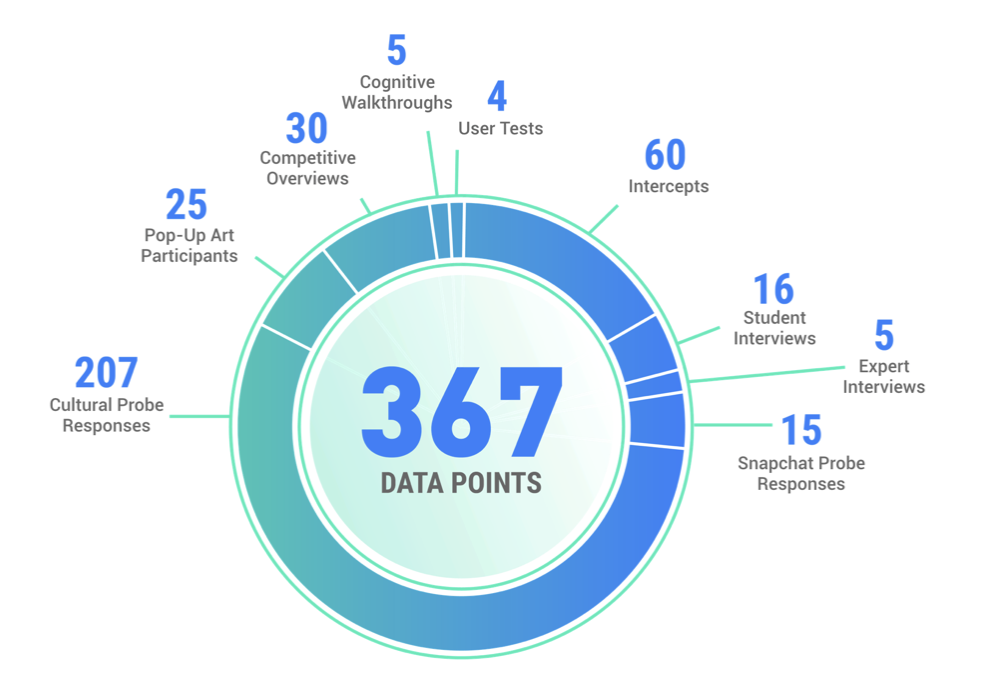In this six month long project with Learning Design Labs in collaboration with Hawaii Department of Education, I worked as lead UX researcher and a concept developer during the ideation phase. Upon implementation, I was head of UX research, focusing on research on assessment and student work
Exploring an LMS with Learning Design Labs to Promote Equity and Excellence in K12 Classrooms
Challenge
Design a Learning Management application that innovative curriculum, instruction, assessment and student work products by highlighting instructional design elements to drive equity and excellence.
Solution
SkillsB is an application learning management platform used to help students communicate with their teachers and allows users to collaborate through problem solving activities in order to build relationships and connections in an overpopulated classroom.
Research
Upon receiving our prompt, we were cognizant of its complexities. Therefore, we deconstructed the prompt into tangible subproblems, which we tackled by establishing research goals.
RESEARCH GOALS
RESEARCH METHODOLOGIES
As UX Research Lead, I guided the team through nine different research methodologies to collect data on each facet of the prompt in order to answer our research goals.
PRELIMINARY SURVEY
We sent out a preliminary survey to gain insight at a larger scale into how often our target users feel inequity and what types of situations perpetuate this feeling.
The survey questioned users about how they measure the authenticity of their current relationships with teachers, how inclined they are in answering problems to the best of their ability , and how often they experience inequity.
Insight: Survey results revealed that many participants responded with uncertainty. We realized that this was due to the ambiguity of the client’s initial terminology.
INTERCEPTS
Questions
How often did you need your teacher’s help to solve a problem but he/she was unavailable?
- Very often
- Often
- Not often
- SometimesWhat terms do you use to describe students who are smart in class?
Tell us about a time you solved a school problem online? And what problem was it?
When do you feel the need to ask your teacher questions and how do you do it?
We conducted sixty intercepts with k-12 students to understand their current mental model of equity and excellence in the classroom and how their teacher relationships developed.
“I solve math problems better when my teacher is nice to me and pays attention to me. It helps me feel smart. Like I am a good student”
— Participant
Insight: After gaining a sense of users' mental models, we used this data to scope our interview questions.
Many participants measured the support academic fairness and inclusion by their teacher by the amount of effort he or she put forth, yet many feared reaching out first due to the risk of rejection.
Design, Test, Iterate
We held numerous testing sessions to ensure our product was usable and well-received. Some of these sessions evaluated proof of concept by walking users through various prototypes, while other sessions focused UI specific features using a think-aloud cognitive walkthrough.
Prototype 1: Classroom Space-Based Discovery LMS
Prototype 2: Easier to Implement App with Reward Images
Alpha Solution
While reward images and badges were well-received, engineering constraints moved the Alpha version of the application towards core features only. Once use habits are established, additional reward features will be added as needed. Core features are focused around exercise completion in a fun, collaborative way:
Students are able to quickly and easily monitor weekly progress along fun, educational goals
Students can choose from a variety of exercises to collaborate with peers tailored to daily preferences, instead of being stuck to tasks that may not appeal on a given day
Students are able to access help easily through the “Need Help” button, to address the great need for connection and a sense of help being available whenever needed











